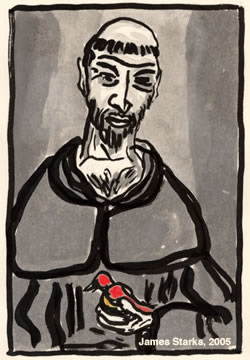| |
 I
Walk with I
Walk with
St. Francis of Assisi
by
Jon M. Sweeney
Portrait of St. Francis of Assisi by
James Starks
I cannot really explain why or how he became the saint that speaks
most directly to me, but I feel a close relationship with Francis
of Assisi and have so since high school. His youthful rebellion
and arguments with his father made perfect sense to me. As a teenager,
Francis had to struggle to figure out the difference between what
his parents wanted for him and what he wanted from himself. Once
he realized that God was his real father, Francis’s  over-earnest
commitment to faith made
sense to me, too. And then his forthright manner, combined with
a personal gentleness, became my ideal. I learn from Francis’s
example and his teachings, and I consciously try to become more
like him. I love the ways in which he was peaceful but not passive,
loving but not always lovable. over-earnest
commitment to faith made
sense to me, too. And then his forthright manner, combined with
a personal gentleness, became my ideal. I learn from Francis’s
example and his teachings, and I consciously try to become more
like him. I love the ways in which he was peaceful but not passive,
loving but not always lovable.
Francis
of Assisi brought light into the darkness of the late Middle Ages.
He was, in the words of Dante, his countryman, the “Morning
Star,” or sun, that rises from the East to shine new light
upon the dawn. Francis’s life was full of poetry—both
lived and spoken. His greatest biographer, Paul Sabatier, goes so
far as to say: “The sermon to the birds and the first Blessing
of the Animals closed the reign of Byzantine art and of the thought
of which it was the image. It is the end of dogmatism and authority.
Uncertainty became permissable in some small measure. It marks a
date in the history of the human conscience.” The
century before Francis Bernardone was born in Assisi, Italy (b.
1170), was one of the most corrupt in the history of the Christian
Church. It was so bad in those days that it was often said that
the majority of priests and bishops were either practicing simony
(extorting money), keeping prostitutes, or both. They were not just
corruptible and prone to adultery, but they were extortionists and
worse. The situation in France and Italy was such that it could
not even be covered up. There was widespread opinion among the good
elements of the Church leadership that the pope must deal severely
with the negative elements, but there was also fear that his sanctions
would be so widespread as to induce the faithful into the heresy
of Donatism, a rejection of the Church because of some bad elements
in it. Nevertheless,
in several encyclicals published between 1074 and 1109, Pope Gregory
VII told all Christians that they must reject the sacraments given
from the hands of corrupt priests. These letters sent out into the
parishes and read aloud in public squares caused riots. Remember:
This was the late Middle Ages. The Church stood at the center of
public life. Religion—which was only Christianity in many
of these communities—was not a private affair, but a series
of public pieties and obligations, all of which depended on the
Church and the local priest for their authority. It
was into these troubled and confusing times that Francis was born.
I will not outline his life story for you, here. Go and read Chesterton’s
life of Francis, or Julien Green’s God’s Fool,
or The Road to Assisi, by Paul Sabatier. All of these will
give you a good understanding of the little poor man who became
known to the world as St. Francis. It
is his spirit that I still cling to, and I am not alone. Millions
of people pray to Francis for peace. His
is a legacy of peace; and even though he didn’t actually pen
that famous prayer, “Lord,
Make Me an Instrument of Peace” (it was written anonymously
a century ago), it is full of his spirit. The stories of the Wolf
of Gubbio and the Preaching to the Birds are not just fanciful tales,
but part of the chronicle of Francis’s extraordinary life.
Sometimes saints make extraordinary things appear ordinary. We can
learn from their examples that transformations of matter through
the power of spirit are within our grasp, too. Francis
knew inner doubt and conflict. He often wondered whether or not
his life—wandering around the hill-top towns of Umbria, preaching
the Good News, caring for lepers, talking with and caring for animals
- was really God’s work, or some sort of ruse. I love him
for that. I pray to Francis in my own moments of self-doubt, asking
him to help me in having the clarity of vision to see God at work
in my life. His
feast day is October 4. He did not die that day so much as he was
born anew. His devotion to the Virgin Mary was great, and wherever
heaven is to be found, Francis is singing the Angelus, there. Also,
he is not only praying for peace, but urging us on toward it.
Copyright
©2005 Jon Sweeney.
ABOUT THE ARTIST:
James Starks is an artist living and working in Memphis, Tennessee.
|




